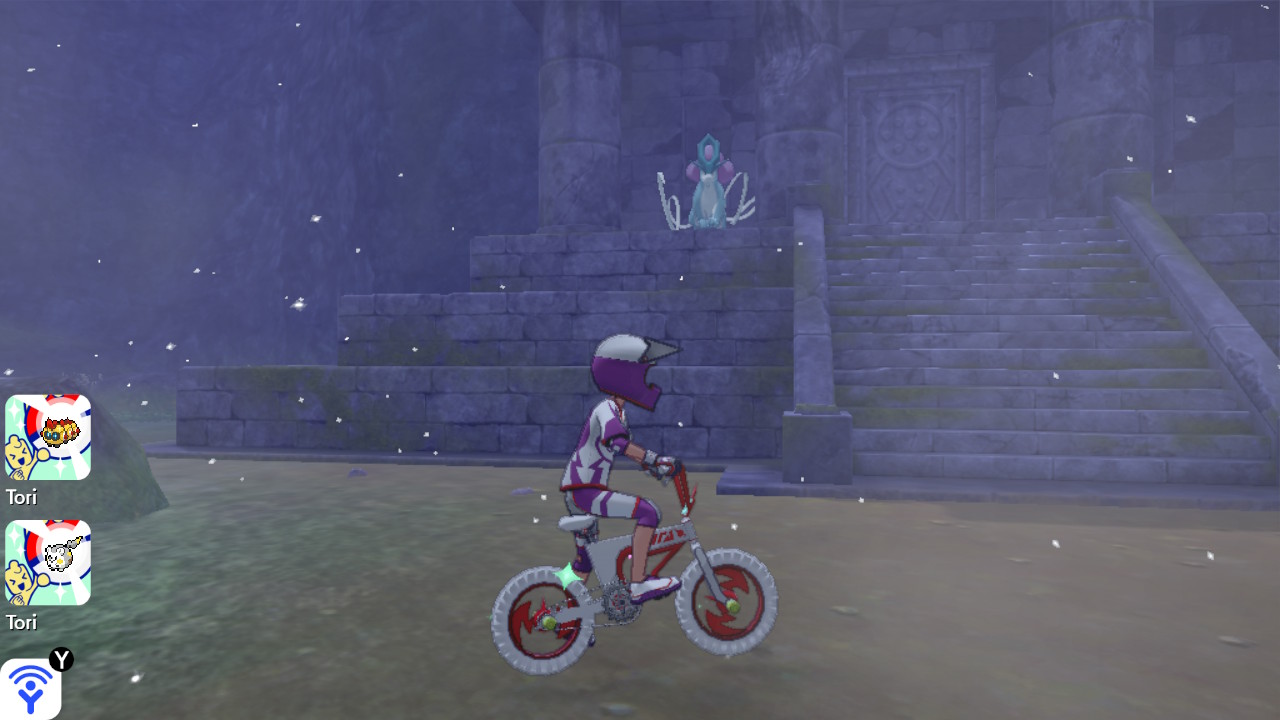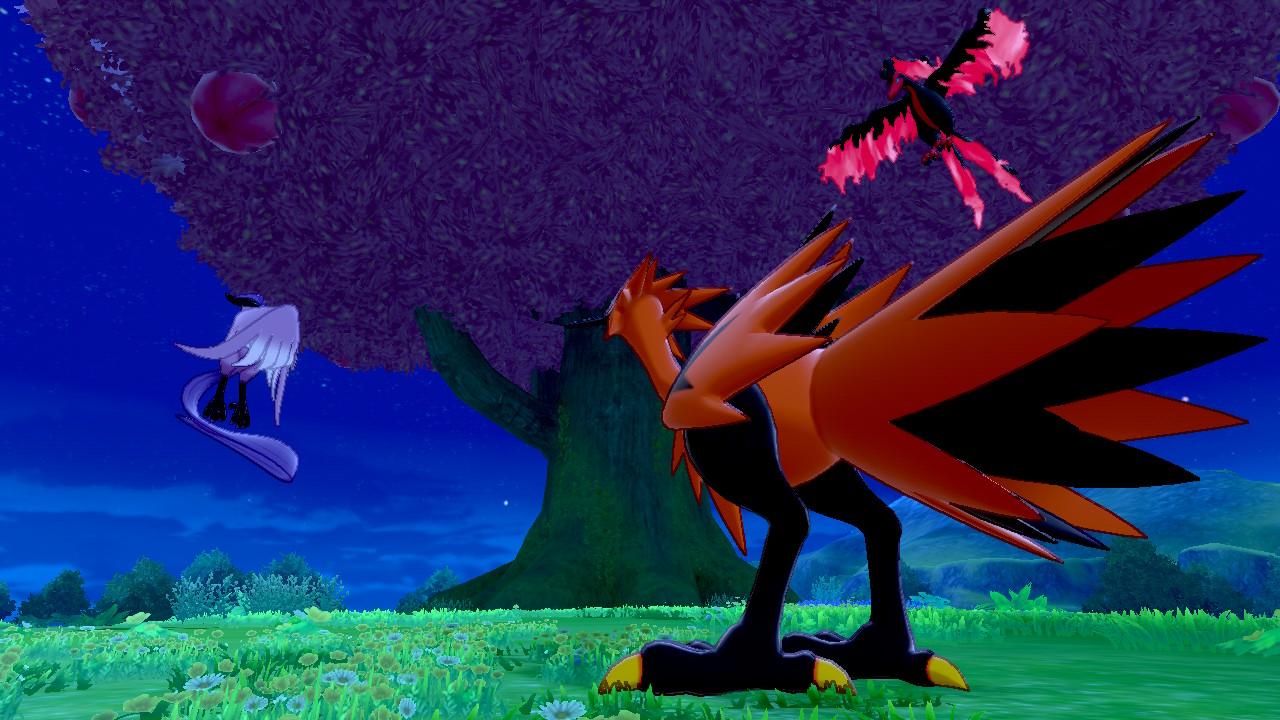I captured a Suicune ten minutes into playing The Crown Tundra, the second part of Pokémon Sword and Shield’s expansion pass that released late last night for Nintendo Switch. Everyone knows what a Pikachu is, but Suicune is another mascot of the series, albeit an understated one. While the expansion is unafraid to introduce some brand-new features, the presence of time-tested classics, like Suicune, is one small yet shining indication that Crown Tundra captures what makes Pokémon so terrific.
The Swarovski-faced dog has had a long and illustrious Pokémon history, first appearing in Gold and Silver as one of the Johto region’s three legendary beasts. In 2003, it was front-and-centre on the box art for Pokémon Colosseum, the unfairly maligned GameCube role-playing game. More recently, it returned as one of the prominent fighters in the Pokémon-themed punch-off, Pokken Tournament.
On a personal level, Suicune is among my favourite Pokémon, though not for any combat prowess. Sure, it has respectable defence and special defence, but Suicine is a bit too slow for my liking, and its versatile moveset is hampered by middling offensive stats. I just like the way it looks. So elegant, so regal. I’d hand over my starter Pokémon for a chance to pet the mane (and, maybe, if I’m lucky, nuzzle that massive face crystal).
[referenced id=”945217″ url=”https://www.kotaku.com.au/2020/06/pokemon-sword-and-shields-new-dlc-finally-lets-pokemon-follow-you-around/” thumb=”https://www.gizmodo.com.au/wp-content/uploads/sites/3/2020/06/18/woyjcma1pstqt4ol7whd-300×169.png” title=”Pokémon Sword And Shield’s New DLC Finally Lets Pokémon Follow You Around” excerpt=”Pokémon Sword and Shield’s Isle of Armour DLC adds a big new area to explore and a bunch more Pokémon to discover, but by far one of the coolest things in it is a new feature that lets you hang out with your favourite Pokémon out in the wild.”]
In The Crown Tundra, as with previous expansion Isle of Armour, your Pokémon can follow you around in the overworld. You’ve long been able to have Pokémon follow you around in Pokémon games; famously, Pokémon Yellow gave you a Pikachu who, like Ash Ketchum’s trusty Pikachu in the show, hated going inside a Pokéball. But this feature is at its best in these Sword and Shield expansions, where Pokémon are done up in magnificent 3D rather than tiny, pixelated sprites. Whichever Pokémon you slot first in your party will trail you like an eager puppy. You can probably guess what happened next:

The feature doesn’t always work, though:

Like Isle of Armour, Crown Tundra takes you to a previously inaccessible section of the Galar region. As with that expansion, you start off by heading to the Wedgehurst train station, where a station agent kindly directs you toward a southbound train en route to the titular Crown Tundra. Once you disembark at your destination, in classic Pokémon fashion, you’re attacked by a Pokémon trainer — in this case, a dude named Peony, who’s travelling with his daughter and, for some reason, winks at you with every phrase. Win or lose, after the battle, you learn that Peony’s daughter used the bout as a distraction so she could escape her father’s overbearing presence and, in even more classic Pokémon fashion, embark on her own adventure. Peony sets off, and you follow into the Tundra.
Crown Tundra’s frigid wild area is a veritable breeding ground for Pokémon from generations past. After just a few hours — most of which have been spent sprinting through the main plot — I’ve seen a Froslass, three Swablu, two Tyrantum, three Tyrunt, a Gible, a Druddigon, half a dozen Aerodactyl, a Metagross (which I tried, and failed, to capture), a Metang, three Beldum, and more Nidoran than I could count. Longtime series fans will be unhappy to hear that Zubat and Golbat, yet again, are everywhere.
But Crown Tundra isn’t all a blast from the past. There are some shiny new features, too. For instance, I didn’t capture that Suicune via the traditional method: running into it in the tall grass, putting it to sleep, carefully whittling its health down, and tossing 19 ultra balls in the hopes that one might do the trick before the sleep wears off. I captured Suicune in a Dynamax Adventure, a serialized battle format new to Crown Tundra.
You start your first Dynamax Adventure once you catch up to Peony again. For plot reasons, you can’t use any of your Pokémon. Instead, you have to borrow just one Pokémon from a randomly generated roster. You’re paired up with three other trainers who also borrow just one Pokémon. (You can play this mode online, cooperatively, but the game nudges you toward teaming up with computer-controlled allies for the tutorial.) Once your team is locked in, you set off into a dungeon with branching pathways. At every intersection, you can cast a vote for one of a handful of chambers, each of which features a different Pokémon type. Whatever chamber you end up will feature a Dynamax Pokémon of that type. (When you play alone, your vote is the only vote that matters.) If you defeat the Pokémon, you’re given the option to capture it and swap out the Pokémon you rented, or move on. At the end of a Dynamax Adventure, you can permanently hold on to one of the Pokémon you caught along the way.
The final chamber of every Dynamax Adventure is home to an extremely powerful Pokémon. As I understand it, I was lucky to end up with a Suicune, my fave. Apparently, other legendary Pokémon, including the fire-type Entei and lightning-type Raiku, Suicune’s counterpups from Gold and Silver, can show up, too. I’m looking forward to capturing them — someday. I’m also keen to see what other legendaries show up. But there’s no urgent thrust motivating me. Already, the Crown Tundra has given me half a team of legendary Pokémon.
Once you wrap up that first Dynamax Adventure, you visit a town (the suitably named Freezington), which serves as your homebase for the rest of the expansion. You learn some story details — something to do with yet another king-god-emperor-deity Pokémon — and are given a three-tiered mission. One has you explore long-lost temples in search of long-dormant giants. (I haven’t touched this quest branch yet, but, presumably, these are the three goliath Pokémon from Ruby and Sapphire.) Another has you track down the three legendary birds — Zapdos, Moltres, and Articuno — from the very first generation of games. And a third is all about capturing that king-god-emperor-deity Pokémon, a psychic-ice ruminant called Calyrex.
I’ve already captured Calyrex, who shows up at level 80 — which should give you an idea of Crown Tundra’s difficulty factor. (It took more than a dozen ultra balls and five K.O.ed Pokémon. In a long shot, I tossed a friend ball and used the classic repeatedly-tap-A-while-furiously-rotating-the-D-pad trick. It worked.) I’ve also tracked down and captured Articuno.

Pokémon is at the height of its powers when marrying the past and the present, when it pushes the envelope without rewriting the language. Crown Tundra is that to a tee. Just look at the legendary birds: All three are still part-flying-type, obviously, but their other primary types have been shifted. Moltres is now part-dark, Zapdos part-fighting, and Articuno part-psychic. Their designs, too, have been updated to reflect these changes.
Those of us who’ve played Pokémon from the beginning have a decades-long imprinted memory of what these iconic avians look like. One of the better innovations of recent Pokémon games has been the introduction of region-specific Pokémon. In hindsight, such a creative choice is plain as a pikestaff. Biological life in the real world isn’t identical from place to place; why shouldn’t it be the same in the Pokémon world? Over the past few mainline games, seeing these reimagined Pokés has always been entertaining (even if some of the results, like Galarian Slowking, are downright terrifying). Seeing these birds — three of the most instantly recognisable Pokémon in history — get the remix treatment should at least provoke some thought in series superfans. If you ask me, I think they’re magnificent.
In my first few hours with The Crown Tundra, it’s been a well-considered mix of old and new, much like these new legendary birds. Embarking on a Dynamax Adventure is a blast, but so is exploring a safari of long-beloved beasts and getting things done the old-fashioned way. (I’ll get you someday, Metagross.) That I can do both in this expansion, at least in the early goings, is a treat. I’m excited to see if the balance holds up the rest of the way.
And no, I haven’t seen one of those Galarian Slowking yet. I hope I never do.
More Pokémon
[referenced id=”945255″ url=”https://www.kotaku.com.au/2020/06/im-loving-pokemon-sword-and-shields-first-expansion-so-far/” thumb=”https://www.gizmodo.com.au/wp-content/uploads/sites/3/2020/06/18/udgnc7lznw9nmyi48hyr-300×168.png” title=”I’m Loving Pokémon Sword And Shield’s First Expansion So Far” excerpt=”Just a few hours in, I’m already enjoying Pokémon Sword and Shield‘s Isle of Armour DLC more than the base game. While much smaller in size, it feels more free flowing and open ended. There’s a lot to explore, and plenty more Pokémon to catch, including a bunch of my…”]

Leave a Reply